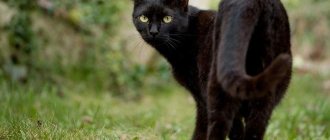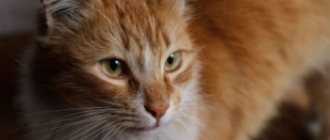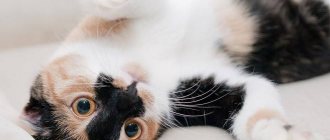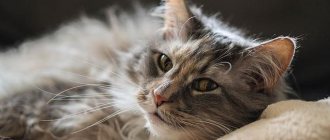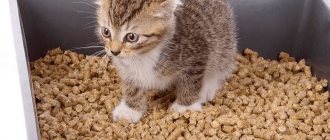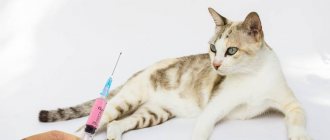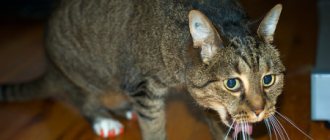Pneumonia in cats, like in humans, is a fairly serious disease. With timely treatment and avoidance of complications, the outcome is often favorable.
Pneumonia is inflammation of the lungs. Pneumonia in cats is most often caused by infection. The disease occurs when the animal is hypothermic when eating frozen food.
Cats with acute or chronic bronchitis are at risk. Keeping cats in damp, cold rooms creates a favorable environment for the occurrence of lung diseases.
Pneumonia is classified:
- Viral pneumonia . Develops as a complication against the background of a viral infection of a cat.
- Bacterial pneumonia . Develops as a complication against the background of a bacterial infection.
- Fungal pneumonia . Caused by fungal microflora.
- Parasitic pneumonia . It develops when parasitized by helminths, the development of which occurs in the lungs. For example, roundworms.
Parasitic and fungal pneumonia are the most difficult to diagnose and often result in death.
Causes of pneumonia
Most often, pneumonia in cats is due to 3 reasons. These include:
- bruises or open wounds of the chest;
- infectious (fungal, bacterial, viral) diseases, helminthiases and protozoan infections;
- involuntary ingestion (aspiration) of liquids (medicines, vomit) and foreign objects (insects, small debris).
Separately, it is worth noting pneumonia in a kitten caused by doctor’s negligence. If the baby is prescribed artificial feeding, then incorrect insertion of the tube can injure his lung tissue.
In addition to the main cause, there are also predisposing factors that undermine the animal’s immunity. These include:
- lack of vitamins and minerals in the diet;
- lack of vaccinations and antiparasitic treatment;
- recent surgery, chemotherapy, or long-term use of immunosuppressive drugs;
- untreated diseases;
- neglect of hygiene;
- the presence of allergic reactions;
- hypothermia;
- frequent stress.
Regardless of the cause, the possible consequences are always equally dangerous. They can be avoided if warning signs are detected early.
Infectious pneumonia
- viral or bacterial infection
- fungal pneumonia (also called mycotic pneumonia)
Inhalation of spores from soil into the lungs is the source of most fungal infections in cats. This type begins as a fungal infection that progresses to pneumonia.
- parasitic pneumonia
Lungworms, including Aelurostrongylus abstrusus and Capillaria aerophile, can infect cats, causing respiratory symptoms. Cats most often encounter these parasites when hunting and eating birds, lizards, snakes, snails and rodents.
Call a veterinarian Moscow
+7(495)162-70-70
Symptoms of pathology
The severity of symptoms of pneumonia in cats depends on the form and severity of the disease. It is most difficult to notice changes in chronic pathology characterized by a sluggish course, or at the very early stage. In these cases, the symptoms are slightly different from the common cold. More precisely, the pathology is confirmed by specific signs:
- discharge of serous (serum-like), fibrinous (dense in consistency) or purulent exudate from the nose;
- frequent sneezing;
- breathing problems and wheezing;
- increased heart rate;
- blueness of mucous membranes;
- dry cough, gradually turning into wet;
- loss of consciousness.
A sick pet loses activity and often sleeps. His appetite decreases or completely disappears. The presence of fever is typical only in cases of infection; in other cases, the temperature does not rise above 0.5 °C.
Danger of pneumonia
Detection of the disease too late can result in damage to most of the lung tissue. This has a detrimental effect not only on the respiratory system, but also on other related organs that fight infectious intoxication.
At-risk groups
The risk group consists of animals deprived of a balanced diet and comfortable living conditions. These include:
- shelter residents living in small, cold spaces with poor ventilation;
- homeless cats forced to fight daily for food and find a roof over their heads;
- pets weakened by chronic diseases or frequent helminthiases.
The age factor should also be taken into account. The weakest immunity is typical for premature kittens and older pets.
Complications
If signs and symptoms of pneumonia appear in a cat, treatment should not be delayed. Diagnosis in late stages leads to an unfavorable prognosis. Prolonged development of the disease is fraught with chronicity of the process, pulmonary edema and blood poisoning.
The kidneys and liver suffer greatly from intoxication. All these changes are a huge burden on the body of a furry pet. With severe damage to the lung tissue, death is inevitable.
What is pneumonia
No matter how much we dream that our cats will always be healthy, sometimes they still get sick. Often the animal's respiratory system is affected, for example, it may develop pneumonia.
Pneumonia is an inflammation of the airways that can be accompanied by a buildup of fluid, pus, or dead cells in the lungs. When the disease occurs, the body's condition seriously deteriorates and breathing problems arise.
According to many years of observations by Murkoshi specialists, this disease is more often observed in kittens or older cats, since their immunity is weakened and therefore they are more susceptible to infectious diseases. But there is no need to worry - with timely treatment and following further recommendations, the disease quickly recedes and the kitten forgets about pneumonia. The main thing is to seek help in time and prevent complications. To do this, let's understand the causes of the disease, its symptoms, treatment methods and prevention.
Types of pneumonia
Based on the severity of symptoms and the speed of progression of pneumonia in cats, acute and chronic forms are distinguished. Secondary inflammations include those that arise due to other diseases. If the pathology developed independently, then it is called primary.
Depending on the degree of lung damage, there are 2 forms: lobar and catarrhal. In the first case, inflammation covers most of the lung tissue, and in the second, only a small area.
Due to the inflammatory process, pathology occurs:
- Aspiration
. Aspiration pneumonia in cats is not associated with infection. It is caused by chest trauma and inhalation of foreign objects or liquids.
- Infectious
. Infectious pneumonia in cats is caused by pathogenic microorganisms: viruses, helminths, bacteria, fungi or protozoan parasites.
The most dangerous forms include bacterial and lobar. If they are detected, artificial ventilation is used to save the animal.
What are the dangers for cats with pneumonia?
Pneumonia is not a localized inflammatory process, but a disease of the entire body as a whole. As a result of the resulting inflammation, various consequences are noted:
• hyperemia and pulmonary edema; • hemorrhages; • proliferation; • atelectasis; • exudation; • poisoning of the body with toxins; • necrosis; • reduction of the respiratory surface of the lungs; • increased respiratory movements; • reduction of oxygen consumption; • reduction of gas exchange in the body; • violation of protein, fat, carbohydrate and vitamin-mineral metabolism; • development of cardiovascular failure.
Accurate diagnosis
Before deciding how to treat pneumonia in a cat, the veterinarian must rule out the presence of pathologies with similar symptoms. A similar clinical picture is typical for pets suffering from calcivirosis, rhinitis, bronchitis, tracheobronchitis and acute tonsillitis. Despite the similarities, the treatment for these diseases is different. Choosing medications on your own can worsen the animal’s condition.
Pathological noises and changes in the boundaries of the affected organ are detected by listening (auscultation) and tapping (percussion) of the chest. This type of examination assesses the physical condition of the lungs.
An x-ray shows a more accurate picture. The veterinarian takes a picture in frontal and lateral projections, which allows one to assess the existing lesions of the lung tissue. The diagnosis is confirmed by identifying a dark spot with blurry boundaries.
The list of mandatory studies also includes blood biochemistry, sputum analysis and bronchial swabs. Based on the results of these tests, the veterinarian confirms the presence of a specific infection. This helps to select drugs aimed at destroying a specific pathogen.
Symptoms of pneumonia
Characteristic symptoms in cats during the development of pneumonia appear only when the process becomes malignant. Thus, the initial stages of the inflammatory process remain invisible to the animal owner for a long time.
The cat may become apathetic and refuse to eat or play. In some cases, the animal tries to find a warm, quiet place, preferring to sleep more. With the development of the pathological process, the general condition of the cat deteriorates sharply, signs of inflammation become noticeable, and in the absence of qualified assistance from a veterinarian, the pet may die.
The onset of pneumonia is characterized by the following symptoms:
- polydipsia (extreme thirst and lack of appetite);
- increased body temperature (nose becomes dry and hot to the touch);
- febrile conditions develop, the breathing process is disrupted, the pulse quickens;
- increased secretion of salivary fluid and discharge from the eyes may occur;
- a cough occurs (wet or dry), and mucous discharge appears from the nasal passages, sometimes mixed with pus, and having an unpleasant, repulsive odor;
- breathing is heavy, whistling or wheezing sounds are pronounced;
- cyanotic appearance of visible mucous membranes (in particular the oral cavity), due to a sharp lack of oxygen;
- exhaustion of the animal against the background of pathology and refusal of food, changes in the coat, loss of shine and elasticity.
Body temperatures during pneumonia in a cat are measured using a mercury thermometer, as it is the most accurate. Normal temperature readings for a cat range from 38.2 to 39.7. Temperatures from 40.1 to 41.4 are considered high.
The persistence of high temperatures and a febrile state in an animal for several hours requires immediate contact with a veterinarian.
How is pneumonia treated in cats?
Features of treatment and the duration of the recovery period depend on the cause of the disease and the degree of tissue damage. At the initial stage, the animal is treated at home.
If there is extensive damage to the lung tissue, trauma or a foreign body is detected, surgery and artificial ventilation may be necessary. In this case, the pet remains in the hospital until the condition stabilizes.
Veterinarian appointments
In addition to oxygen deprivation, dangerous symptoms include severe exhaustion, fever and complete refusal to eat. In all these cases, the mustachioed patient is provided with first aid in a hospital setting.
If the animal’s condition is unstable or critical, it is important to stabilize it and eliminate the cause of the problems that have arisen. Only after this do doctors begin to restore the lungs, relieve symptoms and stimulate the immune system. Dehydrated and malnourished patients are given intravenous drips. Infusion therapy helps restore strength by bypassing regular feeding.
If a bacterial infection is detected, the patient is prescribed antibiotics (Moxifloxacin, Azithromycin, Levofloxacin, Amoxicillin). To achieve quick results, injection solutions are used. Once in the blood, the active substance immediately reaches the desired organ. The duration of antibiotic therapy ranges from 2 weeks to 1 month. Animals infected with legionella or chlamydia take the longest to treat.
In case of fungal or viral infection, antimycotics or antiviral drugs are prescribed. Helminth infections are treated by taking anthelmintics. If complications occur in other organs, cardiac medications and hepatoprotectors may be required, and in case of edema, diuretics (Furosemide).
During treatment, it is prohibited to use antitussives. They prevent the discharge of sputum, worsening the animal's condition. Mucolytics (Mukaltin, Lazolvan) are used to liquefy it, and expectorants and physiotherapy are used to remove it. Recommended procedures include UHF heating, chest massage and electrophoresis. They are carried out until the cough is eliminated, but are prescribed only after the acute form has been eliminated.
Due to prolonged use of antibiotics, which have a detrimental effect on the immune system, all patients are prescribed immunomodulators (Fosprenil, Gamavit). Particular attention is paid to vitamins B and C. They are administered intramuscularly.
Do not use traditional medicines that are not approved by your doctor. They are effective only in complex therapy and do not eliminate the root cause. Herbal treatment to increase immunity is permissible only in the absence of allergies.
Nutrition and care
A pet with a stable condition and an awakened appetite can be treated at home. He will need a quiet and warm place to recover comfortably. Remember that both drafts and heating devices located too close are equally dangerous for the patient. If the animal is cold, cover it with a blanket or blanket.
Also remember to make sure there is no noise. Place the sick cat in a quiet room and temporarily limit his contact with children.
If you have your own home, then do not let your pet outside during the entire recovery period. Low temperature, which is a provoking factor, can negate treatment. Provide fresh air with regular ventilation and purchase a humidifier.
If there is an increased accumulation of secretions in the bronchi, massage or heating with an infrared lamp is allowed. The veterinarian will clarify the specifics of these procedures.
To restore strength, your mustachioed pet will need a balanced, low-fat diet. Food should be satisfying, but easily digestible. When feeding naturally, focus on foods rich in potassium and vitamins A, B and C.
To reduce the load on the stomach, reduce the usual portions and increase the number of feedings to 6 times a day. Do not forget to monitor the sufficient amount of water, its freshness and temperature - too cold dishes and liquids can aggravate the patient’s condition.
Recovery period
On average, recovery takes from 3 to 6 weeks, but in particularly severe cases it can take up to 2 months. The duration of the rehabilitation period depends on:
- compliance with care and feeding recommendations;
- degree of damage to lung tissue;
- general condition of the patient;
- severity of existing symptoms.
Adjustment or discontinuation of drug therapy is determined using x-rays. The frequency of examinations is individual and agreed with the attending physician.


